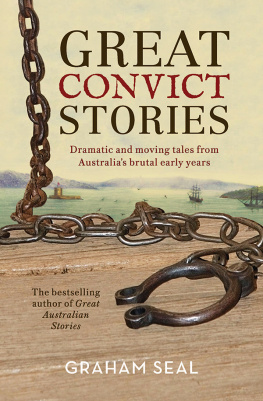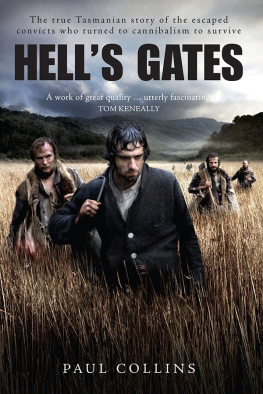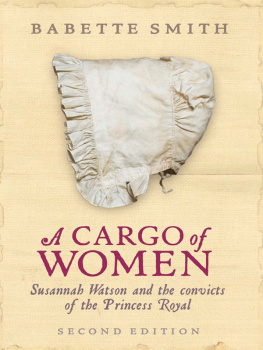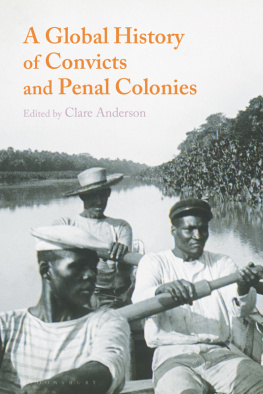CLOSING
HELLS
GATES
CLOSING
HELLS
GATES
the death of a convict station
HAMISH MAXWELL-STEWART

First published in 2008
Copyright Hamish Maxwell-Stewart 2008
All rights reserved. No part of this book may be reproduced or transmitted in any form or by any means, electronic or mechanical, including photocopying, recording or by any information storage and retrieval system, without prior permission in writing from the publisher. The Australian Copyright Act 1968 (the Act) allows a maximum of one chapter or 10 per cent of this book, whichever is the greater, to be photocopied by any educational institution for its educational purposes provided that the educational institution (or body that administers it) has given a remuneration notice to Copyright Agency Limited (CAL) under the Act.
Allen & Unwin
83 Alexander Street
Crows Nest NSW 2065
Australia
Phone: (61 2) 8425 0100
Fax: (61 2) 9906 2218
Email: info@allenandunwin.com
Web: www.allenandunwin.com
National Library of Australia
Cataloguing-in-Publication entry:
Maxwell-Stewart, Hamish.
Closing hells gates: the death of a convict station.
ISBN: 978 1 74175 149 9 (pbk.)
ConvictsTasmaniaSarah IslandHistory.
PrisonsTasmaniaSarah IslandHistory.
Penal coloniesTasmaniaSarah IslandHistory.
Penal coloniesTasmaniaMacquarie HarbourHistory.
Sarah Island (Tas.)History18031851.
Macquarie Harbour (Tas.)History.
Macquarie Harbour Penal Settlement.
994.66
Cover and internal design by Kirby Stalgis
Index by Russell Brooks
Maps on pages viii and ix by Simon Barnard
Set in 10/13.5 pt Adobe Caslon Pro by Bookhouse, Sydney
Printed in Australia by McPhersons Printing Group
10 9 8 7 6 5 4 3 2 1
For Clare
A ship negotiating the passage through Hells Gates into Macquarie Harbour, with James Lucas and his crew in the foreground. (Artist unknown)
Contents
1. Pilot Station
2. Hells Gates
3. Liberty Point
4. Coal Head
5. Phillips Island
6. Brickmakers Bay
7. Settlement Island
8. Small Island
9. Soldiers Island
10. Farm Cove
11. Kellys Basin
12. Charcoal Burners Bluff
13. Birchs Inlet
14. Gordon River
15. Lime Kiln Reach
1. Sawpits
2. Shipwright
3. Boat crew hut
4. Blacksmith
5. New penitentiary
6. Old penitentiary
7. Cook house
8. School house
9. Carpenter
10. Shoemaker
11. Wartons and Douglass quarters
12. Commissariat and engineer store
13. Bakehouse
14. Tannery
15. Gaol
16. Guard house
17. Barracks
18. Chaplains house
19. Surgeons quarters
20. Commandants quarters
21. Lookout house
22. Mortuary
23. Hospital
24. New Sawpits
25. Gardeners hut
26. Flagstaff
Gardens 
Plots 
Fences 
Paths 
Where men are bound both hand and foot
Fast to the fatal wood,
From mangled flesh thats basely cut
Runs streams of British blood.
John Thompson, aged 22,
prisoner, Macquarie Harbour penal station
Detail from Thomas Scotts 1824 map of Van Diemens Land showing the uncharted wilderness that surrounded Macquarie Harbour.
Plutos land
At the farthest corner of an island, at the very end of the world, lies a windswept shore that was once home to some of historys most isolated outcasts. Cut off by mountain ranges it served as a place of exile within a land of exile, a prison within a prison. Some of those who were sent there talked as though they had slipped below the crust of the earth to dwell in some terrible netherworld. They called this place Plutos land, after the kingdom of the Roman god who ruled over the dead. Others knew the area as Macquarie Harbour, a vast body of water that interrupted the western coast of Van Diemens Land. Although it may not technically have been an underworld, it was universally regarded as a sinkthe rubbish pit of the British Empire.
From 1787 onwards the British transported convicted prisoners to Australia. They were sent first to New South Wales, but after the discovery that Van Diemens Land was separated from the mainland by Bass Strait, increasing numbers of convicts were despatched there too. Although the first detachments were sent to secure the territory as a British possession, they later became the labour force that powered the process of colonisation. Between 1803 and 1853 around 73,500 were landed in Van Diemens Land. They cleared timber, built houses, bridges, roads and wharves, and prepared the way for wider settlement. The work to which they were put ensured that their new environs would be far from gaol-like. Most of the convicts were not locked up at night and during the day almost all of them were set to work unencumbered by leg irons or other physical restraints. Those who encountered official wrath, however, could be transported for a second time. They were shipped to one of several penal stations of which Macquarie Harbour was perhaps the most notorious.
According to the nineteenth-century historian, John West, this far-flung region was a place sacred to the genius of torture, separated from the rest of the world by impenetrable forests, skirted with an impervious thicket. It was the lowest reach of the British penal system, a forlorn outpost where every object wore the air of rigour, ferocity and sadness. Writing nearly two decades after the Macquarie Harbour penal station had been abandoned, it was for West a place associated exclusively with remembrance of inexpressible depravity, degradation and woe, a nightmarish world where man lost the aspect, and the heart of man!
Given the difficulties of getting to Macquarie Harbour it is incredible that any convicts were shipped there. It was a remote spot, beyond the pale of colonial society. A bleak anchorage located at the back of a wind-blasted, rain-soaked shore. But between January 1822 and December 1833 some 1136 male and sixteen female prisoners were battened down below decks and shipped to this isolated station. In August 1828, at the height of the settlement, 386 prisoners were secured there on two small islands surrounded by an expanse of water, which in turn was ringed by mountain ranges. The convicts themselves immortalised the terror of the place in The Cyprus Brig, a ballad considered to be so subversive that it was said to have been suppressed:
When we landed in this colony to different masters went,
For little trifling offences boys to Hobart Town gaol were sent,
Now the second sentence we received and ordered for to be,
Sent to Macquarie Harbour, that place of tyranny.
Despite its size, Macquarie Harbour had at first escaped European attention. Flinders sailed clean past the narrow entrance in 1798. Driven by high winds, he had left a warning of the dangers of that gale-ravaged coast for the benefit of future mariners. In his journal he wrote it is as dreary and as inhospitable a shore as has yet been discovered; and the great swell sufficiently announces, that the consequence of coming near it... with a south westerly gale and a dull sailing vessel would be to be wrecked upon it.
Next page













